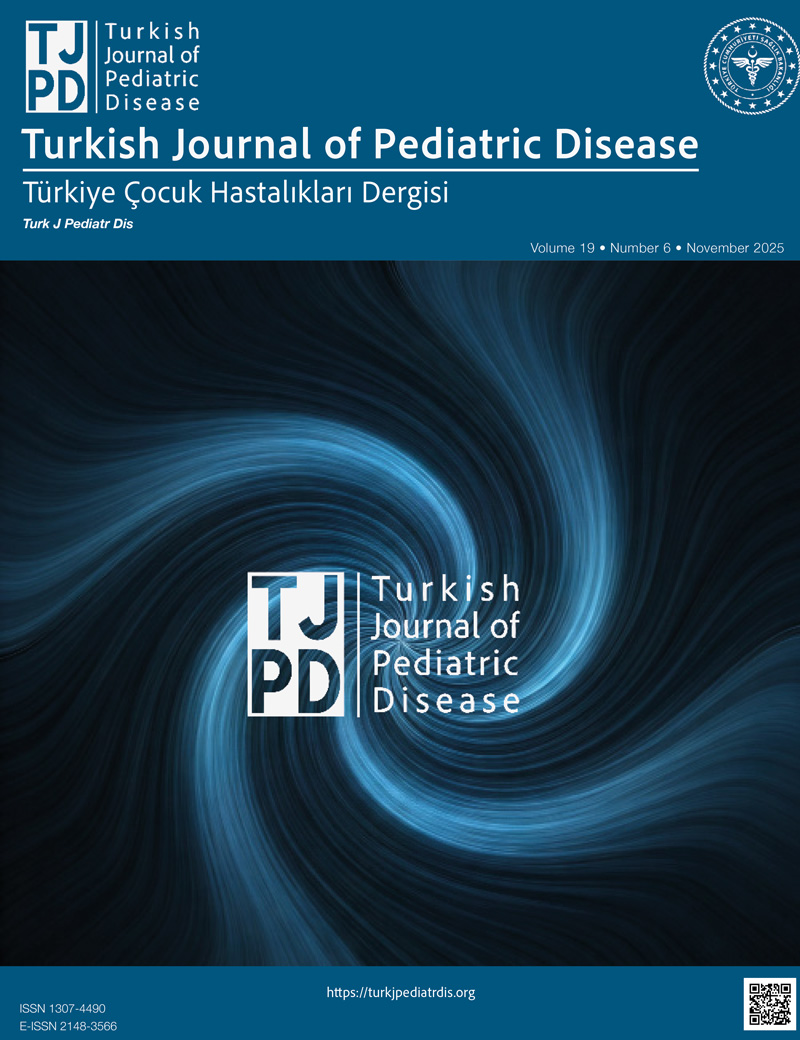Abstract
Objective: The aim of this study was evaluate the effect of enteral nutrition during treatment in preterms under 32 weeks of gestation with patent ductus arteriosus receiving medical treatment.
Material and Methods: Preterm newborns born before 32 weeks of gestation who received medical treatment for patent ductus arteriosus were categorized into three groups based on their enteral feeding status during treatment: Group A (not fed), Group B (fed <60 ml/kg/day), and Group C (fed ≥60 ml/kg/day). Gastrointestinal system problems and neonatal morbidities were compared with nutritional status. In this retrospective study, 105 patients were included.
Results: Gastrointestinal intolerance was more common in group A, which was never fed (p=0.017) and the time to full enteral nutrition was the longest in this group (p=0.024). In the most fed group C, the time to regain birth weight was the longest (p=0.002). Daily weight gain was the lowest in patients in group A (p=0.022) and mortality was the most common in this group (p=0.003). There was no statistically significant difference in the incidence of bronchopulmonary dysplasia, necrotizing enterocolitis, intraventricular hemorrhage and sepsis between fed and unfed infants.
Conclusion: No statistically significant adverse effects of enteral feeding were observed in preterms treated medically for patent ductus arteriosus. This study shows that enteral feeding does not increase gastrointestinal or neonatal morbidities, and that feeding during treatment appears to be safe
Keywords: Enteral feeding, newborn, patent ductus arteriosus, preterm infant
References
- Su BH, Lin HY, Chiu HY, Tsai ML, Chen YT, Lu IC. Therapeutic strategy of patent ductus arteriosus in extremely preterm infants. Pediatr Neonatol. 2020;61(2):133-41. https://doi.org/10.1016/j.pedneo.2019.10.002
- Jin ZW, Yamamoto M, Kim JH, Murakami G, Wilting J, Rodríguez-Vázquez JF. Changes in topographical relation between the ductus arteriosus and left subclavian artery in human embryos: a study using serial sagittal sections. Folia Morphol (Warsz). 2019;78(4):720-8. https://doi.org/10.5603/FM.a2019.0028
- Gillam-Krakauer M, Mahajan K. Patent ductus arteriosus. 2017. https://doi.org/10.1542/9781610021258-part01-ch13
- Kritzmire SM, Boyer TJ, Singh P. Anesthesia for patients with patent ductus arteriosus. 2021.
- Prescott S, Keim-Malpass J, Ikuta L, Zukowsky K. Patent ductus arteriosus in the preterm infant. Adv Neonatal Care. 2017;17(1):10-8. https://doi.org/10.1097/ANC.0000000000000340
- Van Overmeire B, Chemtob S, editors. The pharmacologic closure of the patent ductus arteriosus. Semin Fetal Neonatal Med. 2005;10(2):177-84. https://doi.org/10.1016/j.siny.2004.10.003
- Freeman-Ladd M, Cohen JB, Carver JD, Huhta JC. The hemodynamic effects of neonatal patent ductus arteriosus shunting on superior mesenteric artery blood flow. J Perinatol. 2005;25(7):459-62. https://doi.org/10.1038/sj.jp.7211294
- Erdeve Ö, Okulu E, Singh Y, Sindelar R, Öncel MY, Terrin G, et al. An update on patent ductus arteriosus and what is coming next. Turk Arch Pediatr. 2022;57(2):118-24. https://doi.org/10.5152/TurkArchPediatr.2022.21361
- De Boode WP. Individualized hemodynamic management in newborns. Front Pediatr. 2020;8:580470. https://doi.org/10.3389/fped.2020.580470
- Hamrick SEG, Sallmon H, Rose AT, Porras D, Shelton EL, Reese J, et al. Patent ductus arteriosus of the preterm infant. Pediatrics. 2020;146(5):e20201276. https://doi.org/10.1542/peds.2020-1209
- Zi-Yun X, Ruo-Lin Z, Yue-Wei X, Tao B. Efficacy and safety of oral acetaminophen for premature infants with patent ductus arteriosus: a meta-analysis. Front Pharmacol. 2022;12:696417. https://doi.org/10.3389/fphar.2021.696417
- Oncel MY, Erdeve O. Oral medications regarding their safety and efficacy in the management of patent ductus arteriosus. World J Clin Pediatr. 2016;5(1):75-81. https://doi.org/10.5409/wjcp.v5.i1.75
- Shah SS. Ibuprofen for the prevention of patent ductus arteriosus in preterm and/or low birth weight infants. Cochrane Database Syst Rev. 2020;2020(1):CD003481. https://doi.org/10.1002/14651858.CD010061.pub4
- Gillam-Krakauer M, Reese J. Diagnosis and management of patent ductus arteriosus. Neoreviews. 2018;19(7):e394-402. https://doi.org/10.1542/neo.19-7-e394
- Park J, Yoon SJ, Han J, Song IG, Lim J, Shin JE, et al. Patent ductus arteriosus treatment trends and associated morbidities in neonates. Sci Rep. 2021;11(1):10689. https://doi.org/10.1038/s41598-021-89868-z
- Clyman R, Wickremasinghe A, Jhaveri N, Hassinger DC, Attridge JT, Sanocka U, et al. Enteral feeding during indomethacin and ibuprofen treatment of a patent ductus arteriosus. J Pediatr. 2013;163(2):406-11.e4. https://doi.org/10.1016/j.jpeds.2013.01.057
- Louis D, Torgalkar R, Shah J, Shah P, Jain A. Enteral feeding during indomethacin treatment for patent ductus arteriosus: association with gastrointestinal outcomes. J Perinatol. 2016;36(7):544-8. https://doi.org/10.1038/jp.2016.11
- Martini S, Aceti A, Galletti S, Beghetti I, Faldella G, Corvaglia L. To feed or not to feed: a critical overview of enteral feeding management and gastrointestinal complications in preterm neonates with a patent ductus arteriosus. Nutrients. 2019;12(1):83. https://doi.org/10.3390/nu12010083
- Cakir U, Tayman C. What should be the first-line treatment for the closure of hemodynamically significant patent ductus arteriosus in premature infants? Arq Bras Cardiol. 2022 Mar;118(3):548-55.
- Kelleher J, Salas AA, Bhat R, Ambalavanan N, Saha S, Stoll BJ, et al. Prophylactic indomethacin and intestinal perforation in extremely low birth weight infants. Pediatrics. 2014;134(6):e1369-77. https://doi.org/10.1542/peds.2014-0183.
Copyright and license
Copyright © 2025 The Author(s). This is an open access article distributed under the Creative Commons Attribution License (CC BY), which permits unrestricted use, distribution, and reproduction in any medium or format, provided the original work is properly cited.






